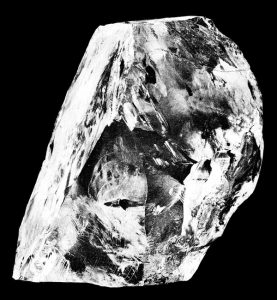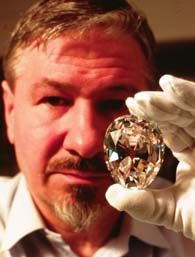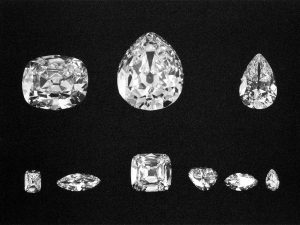cullinan diamond

 It is the symbol of love. It’s a big part of the thing every girl wants to receive from the man she loves. Lot’s of people think that the size of the diamond is a show of stature, and I suppose it is, but there can be a point that would qualify as extreme. Such was the case on January 25, 1905, at the Premier Mine in Pretoria, South Africa, when a 3,106 caret diamond was discovered during a routine inspection by the mine’s superintendent. Weighing 1.33 pounds, and christened the “Cullinan,” it was the largest diamond ever found. Now, girls…I’m sure that you would love to have a large diamond ring, but carrying around a 1.33 pound ring on your finger would be just a little bit much. Still, I would have thought that the owner might have cut the stone into as large a cut stone as possible to be used for a museum piece, but he had very different plans.
It is the symbol of love. It’s a big part of the thing every girl wants to receive from the man she loves. Lot’s of people think that the size of the diamond is a show of stature, and I suppose it is, but there can be a point that would qualify as extreme. Such was the case on January 25, 1905, at the Premier Mine in Pretoria, South Africa, when a 3,106 caret diamond was discovered during a routine inspection by the mine’s superintendent. Weighing 1.33 pounds, and christened the “Cullinan,” it was the largest diamond ever found. Now, girls…I’m sure that you would love to have a large diamond ring, but carrying around a 1.33 pound ring on your finger would be just a little bit much. Still, I would have thought that the owner might have cut the stone into as large a cut stone as possible to be used for a museum piece, but he had very different plans.
Frederick Wells was 18 feet below the earth’s surface when his light flashed off of something embedded in the wall just above him. I’m sure he had a pretty good idea of what he had. His discovery was immediately presented to Sir Thomas Cullinan, the mine’s owner. Cullinan decided to sell the diamond to the Transvaal provincial government. Transvaal presented the stone to Britain’s King Edward VII as a birthday gift. They were worried that the diamond might be stolen while in transit from Africa to London, so King Edward VII arranged to send a phony diamond aboard a steamer ship guarded by detectives as a diversionary tactic. While the decoy slowly made its way from Africa on the ship, the Cullinan was sent to England in a plain box. It was an amazing plan, and I can certainly understand their concerns. King Edward VII entrusted the cutting of the Cullinan to Joseph Asscher, head of the Asscher Diamond Company of Amsterdam. Asscher had cut the famous Excelsior Diamond, a 971 carat diamond found in 1893. He studied the Cullinan stone for a full six months before even attempting the cut. On his first attempt, the steel blade broke, with no effect on the diamond. That had to be enough to break his confidence. On the second attempt, the diamond shattered exactly as planned, but Asscher fainted from nervous exhaustion immediately after.
The Cullinan was later cut into nine large stones and about 100 smaller ones. In total, the diamonds were  valued at millions of dollars. The largest stone is called the “Star of Africa I,” or “Cullinan I,” and at 530 carats, it is the largest cut fine quality colorless diamond in the world. The second largest stone, the “Star of Africa II” or “Cullinan II,” is 317 carats. Both of these stones, as well as the “Cullinan III,” are on display in the Tower of London with Britain’s other crown jewels, so I guess that part of the diamond ended up in a museum. The Cullinan I is mounted in the British Sovereign’s Royal Scepter, while the Cullinan II sits in the Imperial State Crown. Both fitting placements for such stones. Of course, the value of the stones would increase with cutting. The original stone was insured for $1,250,000 in 1905, and would be valued at $30,179,000 today.
valued at millions of dollars. The largest stone is called the “Star of Africa I,” or “Cullinan I,” and at 530 carats, it is the largest cut fine quality colorless diamond in the world. The second largest stone, the “Star of Africa II” or “Cullinan II,” is 317 carats. Both of these stones, as well as the “Cullinan III,” are on display in the Tower of London with Britain’s other crown jewels, so I guess that part of the diamond ended up in a museum. The Cullinan I is mounted in the British Sovereign’s Royal Scepter, while the Cullinan II sits in the Imperial State Crown. Both fitting placements for such stones. Of course, the value of the stones would increase with cutting. The original stone was insured for $1,250,000 in 1905, and would be valued at $30,179,000 today.

